Hammocks are a great way of relaxing anywhere, be it when you are camping outdoors, in your garden, or even inside the house. To truly enjoy this experience, though, it has to be safely secured so that you don’t fall and injure yourself when you use it.
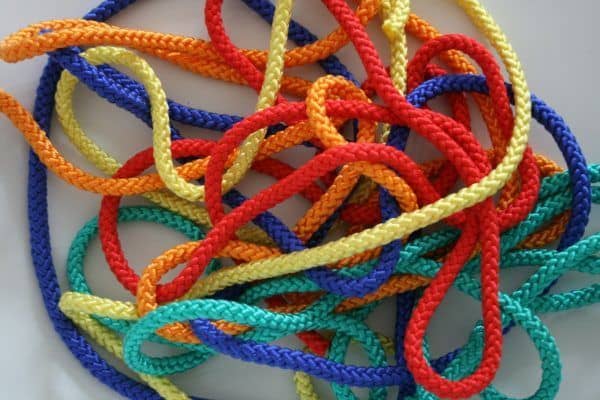
On the other hand, the rope should not be so knotted that you can’t remove it if you want to either. This especially will matter when you are camping outdoors and cannot afford to lose rope by having to cut it every time you want to bring the hammock down!
You may well wonder, is tying a knot rocket science? Let me assure you, it is not. But is it a child’s play? The answer is in the negative again.
Tying a knot, a proper one that is safe and easy to remove, is a skill. And like any other skill, it needs a little practice to be perfected. So if you are planning on a camping trip and are packing that hammock to carry along, make sure you also learn how to tie the correct knot and practice it well. In the wild outdoors, you are not going to get help so it is better to be prepared.
Table of Contents
What Type of Rope Should I Use?
For hammocks, ropes made from natural fibers are usually best, these are typically light brown. Synthetic fibers such as polypropylene or nylon can also be used.
Do be aware that nylon rope can stretch up to 40% of its length like a rubber band when you sit or lie on it. So this will need to be taken into account. Don’t be scared though. If the hammock is secured well, you are still safe.

7 Best Knots for a Hammock
There are several types of knots but only some of them suited for hammocks. The knots should be such that it can withstand the pull effect on the rope when a person sits on the hammock. At the same time, it should be easy to remove whenever you want to. On a camping trip, sudden rains may not leave you with much time to clear up and find some shelter.
Figure 8
Used by rock climbers and often for securing harnesses, this type of knot is very strong and can hold a particular amount of weight. The knot is also easy to remove, making it easy to take the hammock down once you are done using it when camping. If it is in your garden, then this knot makes it easy to remove the hammock in case of bad weather or for cleaning.
This is also referred to as the Flemish knot and is usually the first knot that every climber learns.

Source: Parkis / CC BY-SA (http://creativecommons.org/licenses/by-sa/3.0/)
How to Tie a Figure 8 Knot
In just four steps, you can get your Figure 8 knot right:
- 1Keep your rope flat on the floor.
- 2Take the end of the rope tail over the rope itself, forming a bottom loop.
- 3Tuck the very end of the rope under the standing part of its body.
- 4You can see the rope forming the figure "8." Slip the end of the rope via the loop.
Clove Hitch
This is a quick and dirty knot ideal if you don’t intend to keep the hammock permanently in one place. Used commonly in sailing, the clove hitch knot is used most often for securing the rope to posts, poles, or trees.
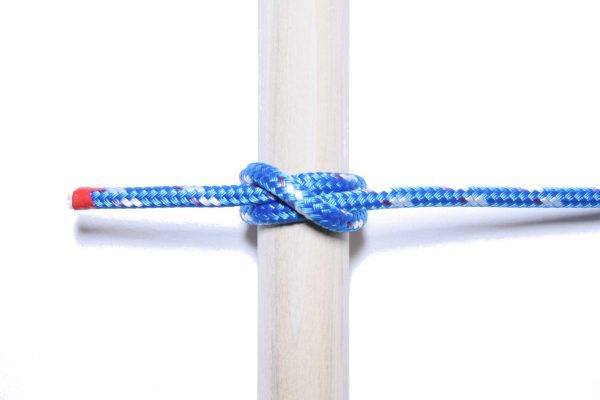
Source: USCG PTC Developer / CC0
How to Tie a Clove Hitch Knot
The clove hitch knot is very easy to learn too:
- 1Loop the loose ends of the rope around a tree or a post.
- 2Cross the ends to form the X figure.
- 3Take the rope ends around the tree or post once again and make another X shape.
- 4You will get two similar shapes. Tighten it by pulling.
To hang hammocks, some make three X figures for extra safety.
Bowline Knot
One of the safest knots, the Bowline knot does not slip and cannot be tied or untied when there is a weight on it. As a result, it is ideal when you want to secure a load or hoist a person up from a difficult location.
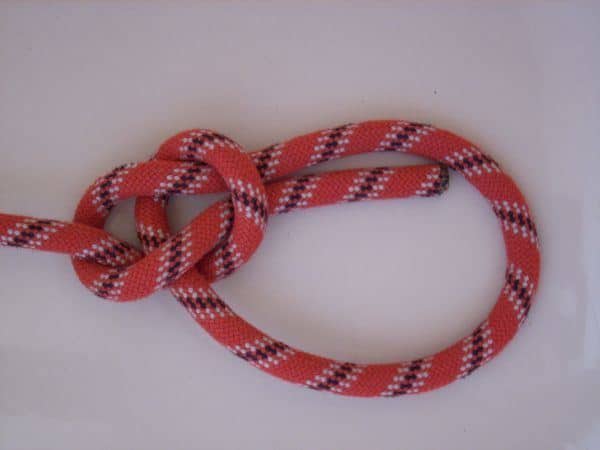
How to Tie a Bowline Knot
This knot is used with an extension of carabiners, rings or chain links of a hammock. To make this knot:
- 1Make a tiny loop in the middle of the rope with enough rope on both sides.
- 2Take the bottom of the rope and run it through the loop.
- 3Let the remaining bit of the bottom of the rope pass through the inner loop.
- 4The tail of the rope must go inside the bottom loop.
- 5Tighten it till the knot is secured.
Modified Bowline
This is similar to the bowline knot. Wrap it a few times around the tree trunk before tying it.
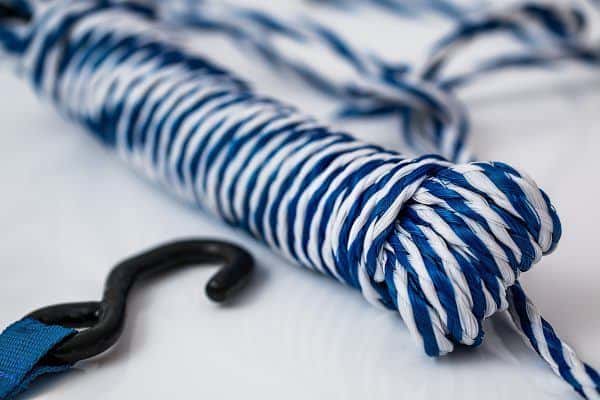
How to Tie a Modified Bowline Knot
- 1Keep the running line in your right hand and the rope’s end in the other.
- 2Make an overhand loop.
- 3Loop the end and pass it to the right hand.
- 4Encircle the tree two to three times and pass the end down via the original loop.
Becket Hitch
This is also called the hammock knot and was originally used to tighten and secure the hammock to the tree. This is an easy and effective knot for beginners and is similar to the sheet bend knot. Since this can damage the bark of the tree, use some padding.
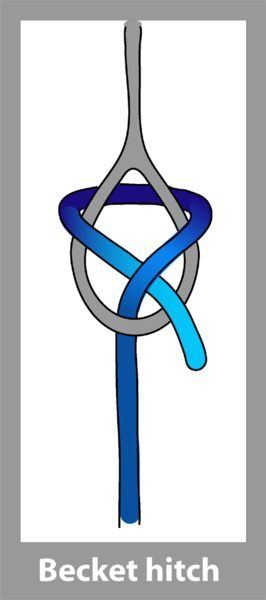
How to Tie a Becket Hitch Knot
This is a good knot to connect two ropes together too. It works this way:
- 1Take one end of the rope and form a loop. Take the free end of the rope and join it under the opening of the loop, then around both parts of the first rope and back under itself.
- 2Now tighten by pulling all four ends.
- 3Make two wraps around both parts of the first rope to make a double sheet bend.
Hammock Knot
This knot is used with carabiners, rings, and tree straps/ webbing and is quite easy.

How to Tie a Hammock Knot
- 1Slip the rope through the carabiner or ring from top to bottom.
- 2Turn the webbing over the top of the carabiner/ ring from right to left.
- 3Loop the tail end of the rope webbing from top to bottom of the carabiner/ ring.
- 4Tighten by pulling the knot.
Wrapped Knot
Wrapped knots are used to secure a knot from an O-ring instead of a closed loop.

How to Tie a Wrapped Knot
You can learn to make this in no time. All you need to do is:
- 1Tie a basic knot on the other end of the ring to secure the cord.
- 2Fold it from a few inches below and take the rope end by pulling it upward back to the ring.
- 3Secure the rope end on the cord at the hammock end firmly.
- 4Push the rope end downwards towards the fold.
- 5Once the wrapped area is a minimum of two inches in length, cross the rope end through the looped area that was folded.
- 6Pull the two ends to tighten.
- 7Tie the upward end to the tree with a basic knot to tie.
Importance of Hammock Knots
Hammocks are a great way to enjoy the outdoors and a beautiful replacement for the tent. Even at home, a hammock can be relaxing. But since it takes up a lot of weight, it has to be secured tightly.
When you do not secure it tightly, the hammock is likely to come loose and you are likely to get injured. If you fall on grassy terrain, it may not be such a bad thing. But if you have tied your hammock across a brook with jutting stones or at a height, then it can be serious.
Prevention Better Than Cure
The knot is very important. In addition, select your trees or the ends to which you tie your hammock after proper examination. The integrity of the tree you are tying your hammock to is just as important. If you tie it to a dead tree or a young sapling, then it can collapse under pressure.

The rope you use also matters. If your rope is damaged or weak, it may not be able to withstand the pressure because of your weight and snap.
Similarly, wrap the rope around the tree at least twice before tying the knots to reduce the wear and tear of your ropes as well as protect the trees.
An Alternative to Rope?
Hammocks can also be hung using suspension straps, which will eliminate the need for tying knots, but not all hammocks come them so you might need to purchase your hammock straps separately. See our buyers' guide for the best options.
The ropes have the advantage of weighing less as well as costing less. A rope is also more versatile and easy to adjust, giving you more room for maneuvering in unpredictable situations. A rope has multiple uses during a camping trip where you may encounter survival situations.
Some believe that the rope causes damage to the tree they are tied to, but by providing padding with your towel or shirt, you can reduce the impact. If the tree has soft bark, the risk of damage is the same whether you use straps or a rope.
Plan and Prepare
There is no denying the importance of practicing different knots. When you check a video or guide on how to tie the knot, it may seem simple. But the length you leave and how much you tighten it will matter. When you are under stress in live conditions when camping, you will make basic mistakes that can prove injurious to your health.
Before setting out, check the quality of your rope, and buy new ones if you suspect your current one is showing signs of wear and tear, get a new one.
Have Fun Relaxing
Hammocks are a popular way to relax. A professionally set up hammock will make you feel safe and let you enjoy the open sky above, the book you are reading or the nap you are taking while lying on it. But when you do it yourself, the satisfaction is immense. The task itself is so simple that there is no reason why you cannot do it!

So if you have a hammock and you are waiting for someone to put it up in your house, start practicing right now. Choose whichever of the knots you think you can master and practice it. Before inviting others to test the hammock you have hung or before doing it outdoors, get it right at home.
Once you solve this knotty problem, you are good to be on your hammock out there in the wild, open spaces.
